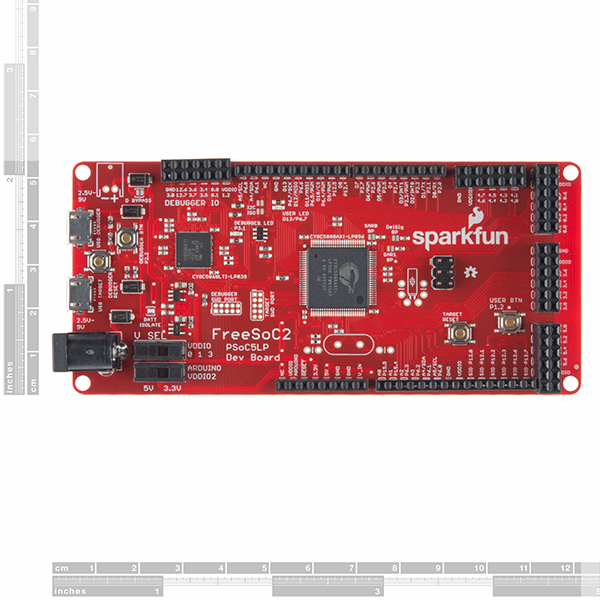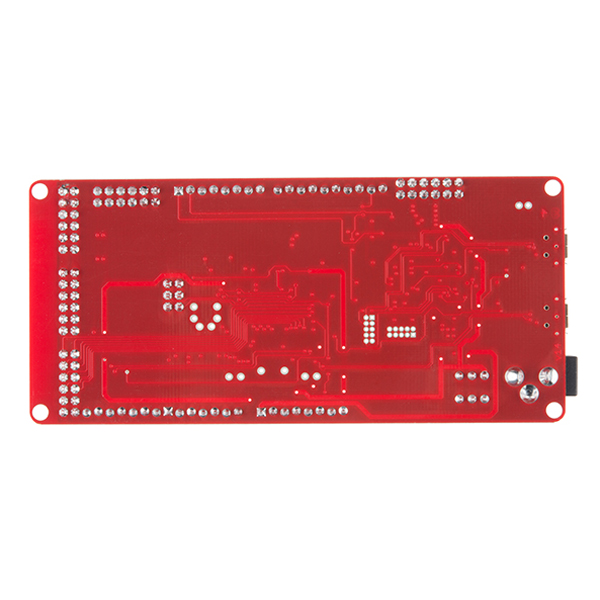FreeSoC2 Development Board - PSoC5LP
This is the FreeSoC2 Development Board, SparkFun’s take on the PSoC5LP ARM Cortex. The PSoC (Programmable System-on-Chip) brings together features of the programmable devices and microcontroller-type systems-on-chips into one package. By placing a programmable fabric between the peripherals and the pins, the FreeSoC2 allows any function to be routed to any pin! Moreover, the onboard PSoC includes a number of programmable blocks, which allow the user to define arbitrary digital and analog circuits for their specific application.
SparkFun’s FreeSoC2 board has two processors onboard: a CY8C5868LTI-LP039 and a CY8C5888AXI-LP096. The former serves as a debugger/programmer for the latter, which is the target upon which your application code will be installed. Both parts contain a Cortex-M3 processor core, 256kB of flash memory, 64kB of SRAM and 2kB of EEPROM. The only significant differences between the two are package size and clock speed. The target is in a TQFP-100 package, which provides 72 I/O pins versus the debugger’s QFN-68 package and 48 I/O pins, and the target can operate at 80MHz versus the debugger’s 67MHz limit. Additionally, the FreeSoC2 can support 5V and 3.3V I/O voltages.
With a simple upload of new firmware, the Arduino core has been ported to the PSoC5LP, so you can write code for the board in the standard Arduino IDE. The board duplicates the functionality of an Arduino Uno R3’s various hardware peripherals on the pins, so many examples, libraries and shields will work on this board. However, to get the most out of the device, you will need to use the PSoC Creator IDE (which is free of charge with no code limits from Cypress Semiconductor). Please keep in mind that the PSoC Creator software is Windows-only at this time.
Note: The FreeSoC2 Develpment Board is a collaboration with Jon Moeller. A portion of each sales goes back to him for product support and continued development.
- CY8C5868LTI-LP039 & CY8C5888AXI-LP096 Cortex-M3 Processor Cores
- 256kB of Flash Memory (each core)
- 64kB of SRAM (each core)
- 2kB of EEPROM (each core)
- Arduino Uno R3-type headers
- Schematic
- Eagle Files
- Hookup Guide
- Making Music with the FreeSoC2
- Datasheet (CY8C58LP Family)
- Arduino Support
- GitHub
FreeSoC2 Development Board - PSoC5LP Product Help and Resources
FreeSoC2 Hookup Guide V14
February 8, 2018
The FreeSoC2 is an Arduino-compatible PSoC5LP-based development board, produced by SparkFun in collaboration with Jon Moeller (developer of the original FreeSoC) and Cypress Semiconductor.
Making Music with the FreeSoC2
August 14, 2015
Create a synth keyboard with the FreeSoC2 from SparkFun.
Core Skill: Soldering
This skill defines how difficult the soldering is on a particular product. It might be a couple simple solder joints, or require special reflow tools.
Skill Level: Noob - Some basic soldering is required, but it is limited to a just a few pins, basic through-hole soldering, and couple (if any) polarized components. A basic soldering iron is all you should need.
See all skill levels
Core Skill: Programming
If a board needs code or communicates somehow, you're going to need to know how to program or interface with it. The programming skill is all about communication and code.
Skill Level: Experienced - You will require a firm understanding of programming, the programming toolchain, and may have to make decisions on programming software or language. You may need to decipher a proprietary or specialized communication protocol. A logic analyzer might be necessary.
See all skill levels
Core Skill: Electrical Prototyping
If it requires power, you need to know how much, what all the pins do, and how to hook it up. You may need to reference datasheets, schematics, and know the ins and outs of electronics.
Skill Level: Rookie - You may be required to know a bit more about the component, such as orientation, or how to hook it up, in addition to power requirements. You will need to understand polarized components.
See all skill levels
Comments
Looking for answers to technical questions?
We welcome your comments and suggestions below. However, if you are looking for solutions to technical questions please see our Technical Assistance page.
Customer Reviews
5 out of 5
Based on 1 ratings:
Very good
I have made my first prorect with PSOC Creator, Super nemt





Can anyone tell me if this kit is CE certified ("European Conformity")? Can it be sold in Europe?
Would it be possible for me to replace or re-create the board with a different chip? more specifically CY8C52AXI-LP095 instead of CY8C5888AXI-LP096? I think it's pin compatible but what do I need to look out for? Thanks!
Is this essentially like an FPGA board? How would it relate to one and using Verilog or VHDL compared to PSoC Creator? I am new venturing into the world of FPGA and wondering if this is similar and might be a good entry point to start migrating from the world of Arduino? Thanks!
I have not used this particular board but I use the CY8CKIT-059 board frequently as well as Xilinx FPGAs. What I can tell you is that if this board is supported by PSOC Creator then it would be a fantastic option to learn about the world of SOCs. Although the Cypress PSOC does support a variant of Verilog, it is better suited using the block design features in PSOC creator to create synthesized logic. If you still need more custom logic than the immense library provided by Cypress than you can create your own state machines and add them to the block design. Then you can run C code on the ARM Cortex-M3 core for your processing needs. Additionally (as if that wasn't amazing enough), Cypress PSOC devices have configurable analog components as well. That means you can have a single design that has digital logic, op-amps..etc, and a processor (trust me I am greatly over-simplifying the abilities of the PSOC here) all without ever turning on a soldering iron. I spent the last 5 years professionally developing atmospheric instrumentation using the Cypress PSOC 5LP and it was an absolute pleasure. Now I work on high end Xilinx FPGA/SOCs and miss my Cypress PSOC days. Take the time and learn Cypress PSOC 5LP and PSOC Creator, do not get sucked into the comfort zone of the Arduino IDE.
Have a good day. What Is the difference between Fresoc 13714 and freesoc 13229?. What Is the update?. Could i install the arduino code?. I have the 13229 versión. I watch that the microcontroller are the same in both boards.
The changes were mostly cosmetic or to address issues discovered in the field. Bypass capacitors around the regulators were adjusted to add a small ESR, the caps on the RTC crystal footprint were replaced with unpopulated through hole capacitor footprints, an isolated plane around the USB ports was added to enhance durability, and some changes to silk were made. I think that’s all of the changes for this version.
What is different from the 2015 version?
I like the idea of an extensible Arduino. I think I will give it a try. for example putting a TIA and 20 bit delta sigma ADC on the same module, with just software and no extra parts, and it still being Arduino compatible might be nice. That assumes I don't completely mess up the Arduinoness implementing the programmable analog.
What does this do that the $10 cypress dev board CY8CKIT-059 doesn't?
This is a higher pin count chip (100 pin QFP instead of the 68 pin QFN) so you have more IO pins. The internal circuitry is the same.
Also this board can operate at either 5V or 3.3V making it easy to hook up to 3.3V peripherals. The CY8CKIT-059 is fixed at 5V.
Other than that, not much.
From the description above: "With a simple upload of new firmware, the Arduino core has been ported to the PSoC5LP..."